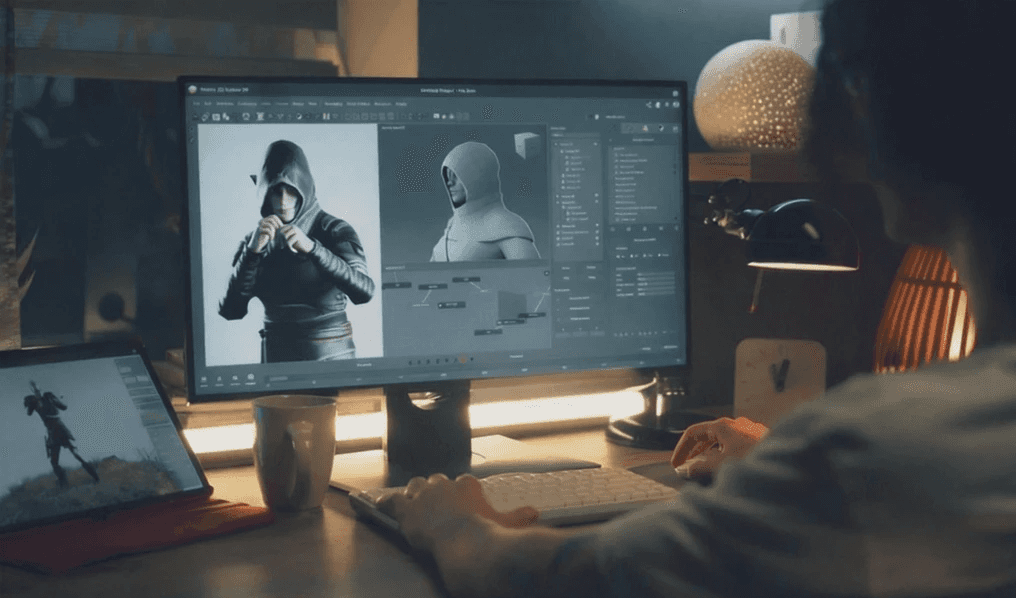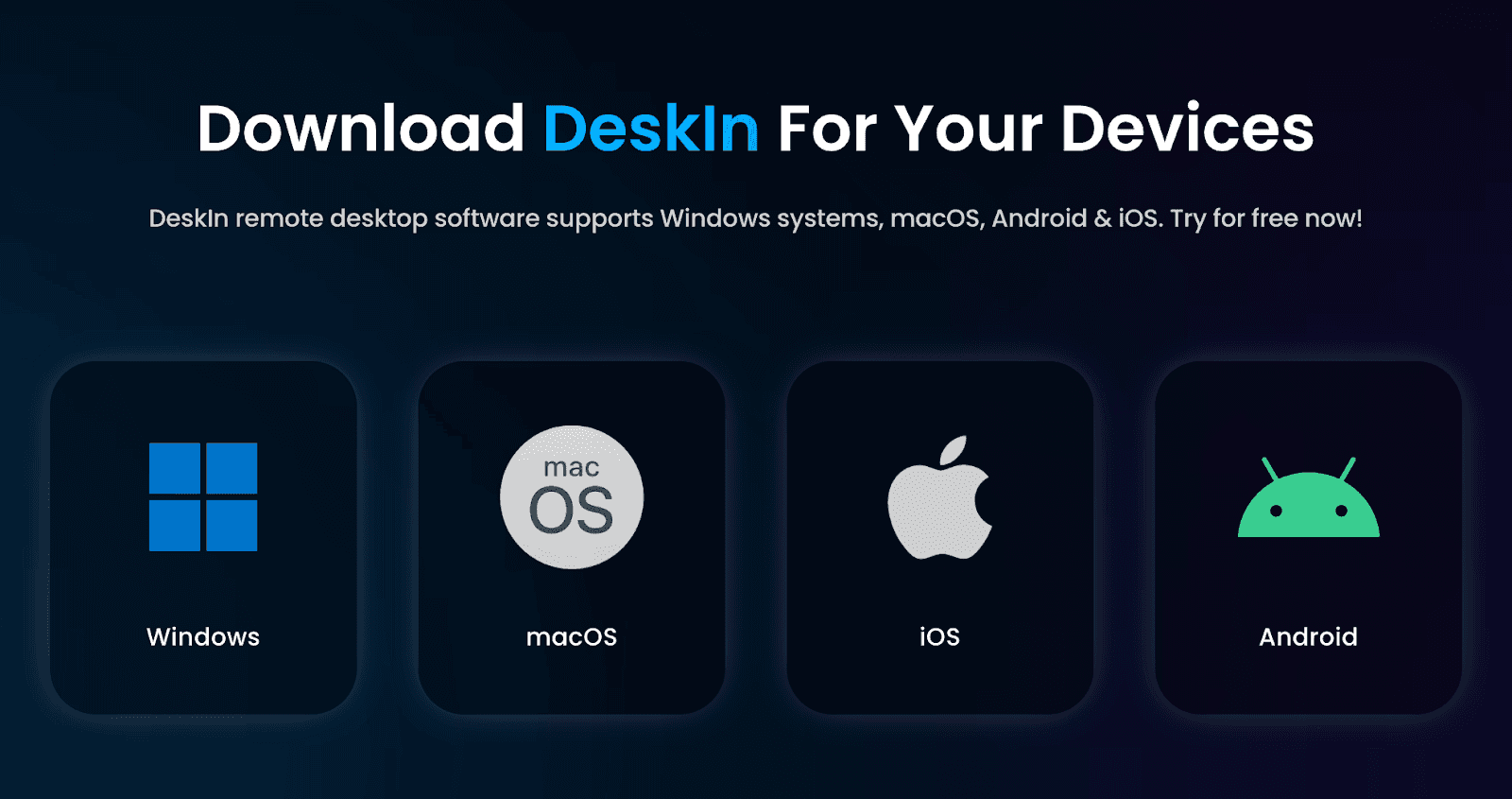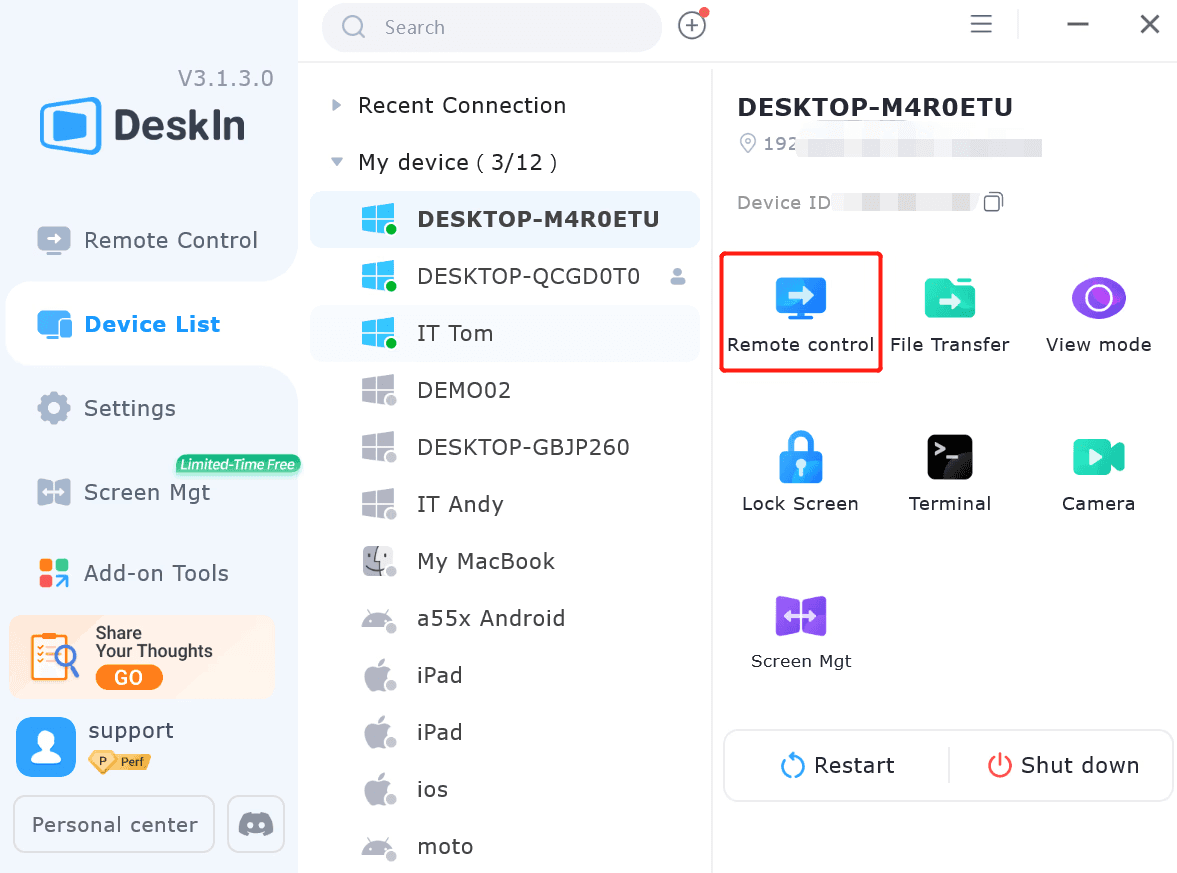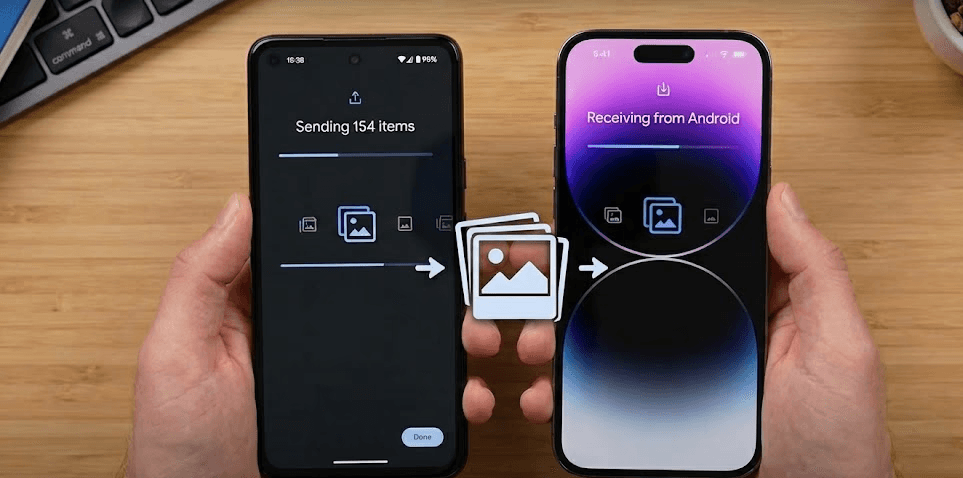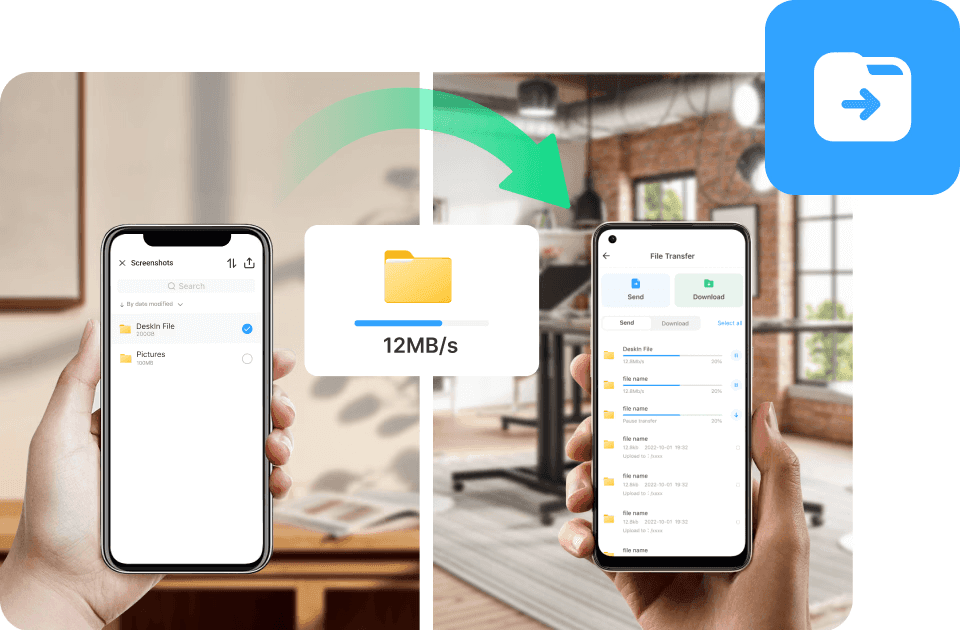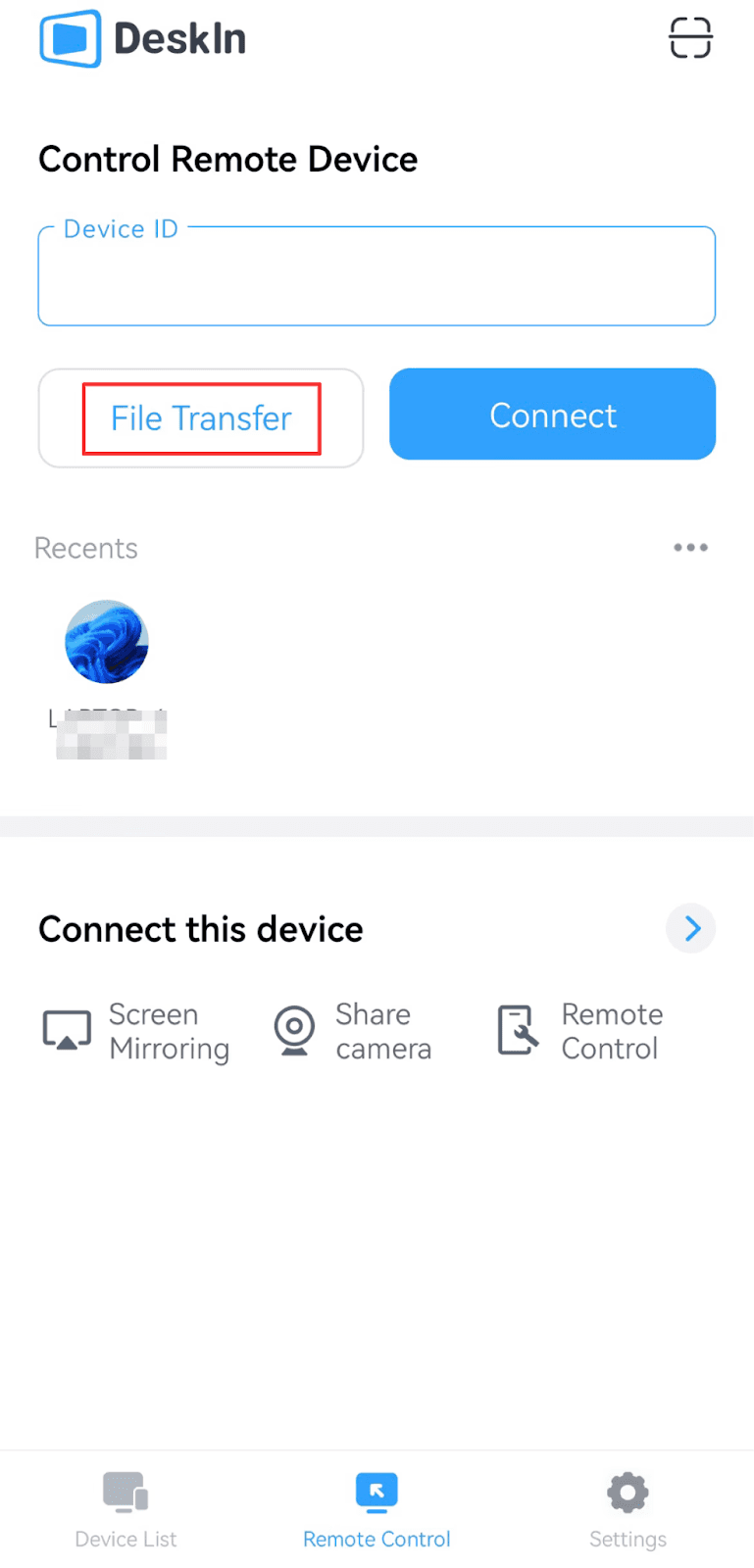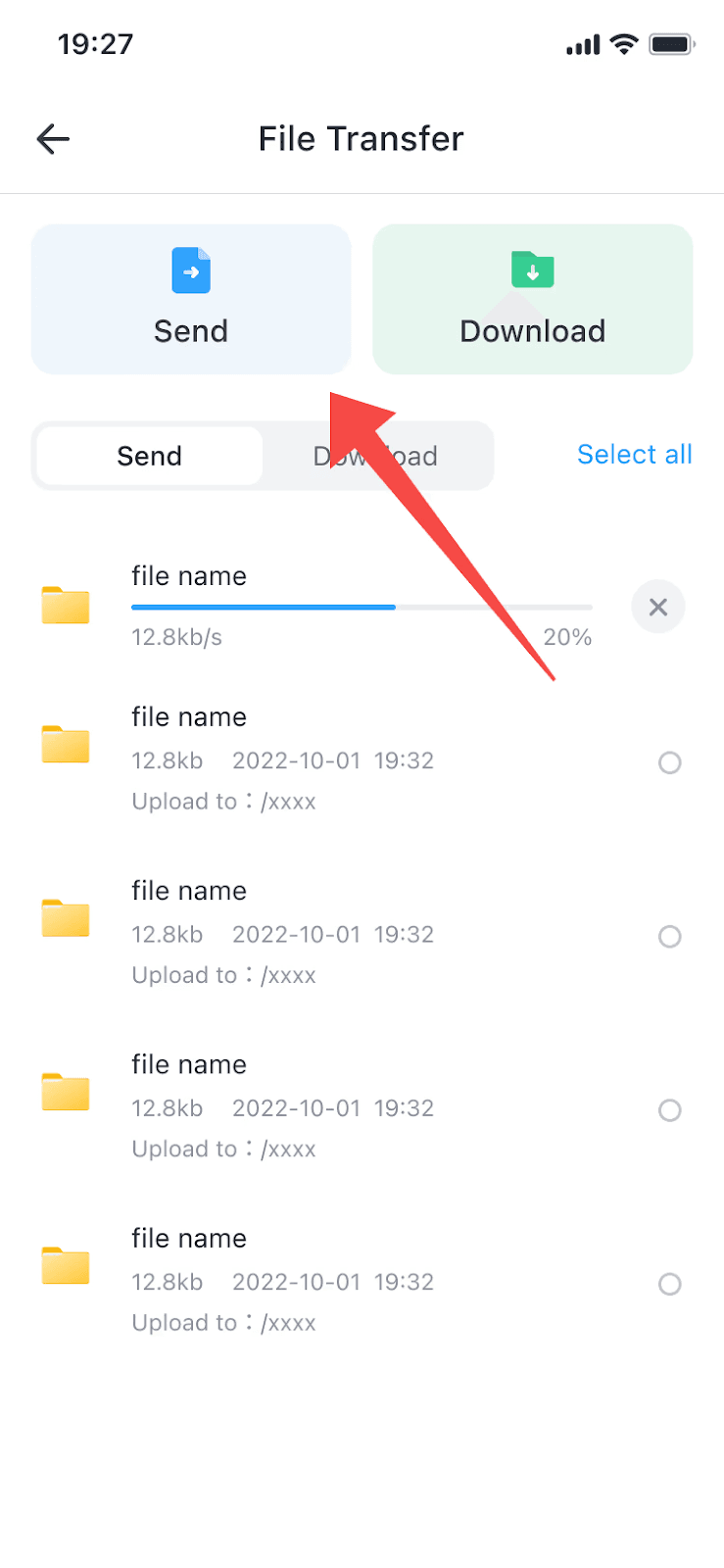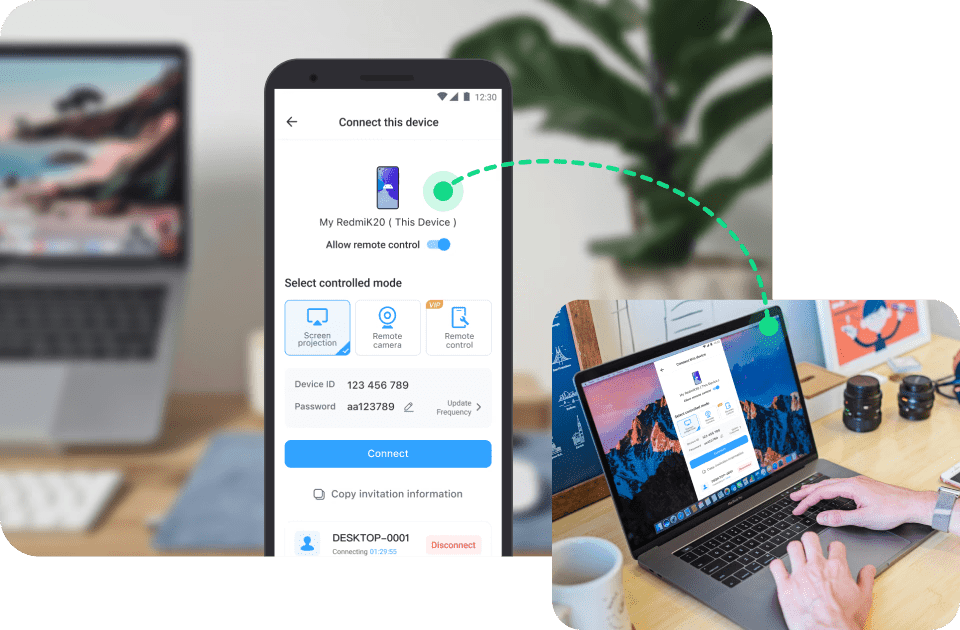Nếu bạn đang sử dụng thiết bị của Apple, bạn có thể thực hiện truyền tệp đơn giản và nhanh chóng giữa iPhone và Macbook của mình với Airdrop. Nhưng điều này chỉ hoạt động với hệ thống iOS và macOS. Ngoài việc sử dụng ổ USB, làm thế nào chúng ta có thể chuyển tệp từ điện thoại hoặc máy tính bảng Android sang PC Windows, hoặc ngược lại? Bài viết này sẽ cung cấp cho bạn 5 giải pháp đơn giản và nhanh chóng.
Phương pháp 1: Gửi tệp qua DeskIn remote desktop
DeskIn là phần mềm remote desktop đáng tin cậy cho phép chuyển tệp đơn giản và nhanh chóng giữa Android và Windows mà không cần phải trên cùng một mạng. Tốc độ và chất lượng chuyển đổi không thua kém gì so với việc chuyển đổi qua cáp USB. Bây giờ, tôi sẽ hướng dẫn bạn cách sử dụng DeskIn để truyền tệp nhanh chóng.
Bước 1: Tải DeskIn
Đầu tiên, cài đặt DeskIn trên Android và Windows, đăng ký một tài khoản miễn phí và đăng nhập. Khi đăng nhập vào tài khoản của bạn lần đầu tiên trên một thiết bị mới, bạn cần hoàn thành xác minh email để đảm bảo an toàn cho tài khoản.

Bước 2: Kết nối và gửi tệp
Sau khi đăng nhập: Nhấp vào "Remote Control" >> nhập ID thiết bị của thiết bị mục tiêu >> "File Transfer".
Nếu bạn muốn gửi tệp từ Android sang Windows, nhấp vào "Gửi" >> Chọn ảnh hoặc tệp mà bạn muốn chuyển >> “Thay đổi đường dẫn” để chọn vị trí chuyển đổi.
Nếu bạn muốn chuyển tệp từ Windows sang Android, nhấp vào "Tải xuống" và chọn tệp mà bạn muốn chuyển.


Phương pháp 2: Gửi tệp qua Bluetooth
Chuyển tệp qua Bluetooth cũng là một phương pháp phổ biến. Dưới đây là cách bạn có thể thực hiện:
1. Bật Bluetooth trên cả thiết bị Windows và Android của bạn: Đi tới Cài đặt >> Bluetooth và bật tùy chọn Bluetooth.
2. Kết nối hai thiết bị
(1) Kết nối từ Windows: "Cài đặt" >> "Bluetooth & các thiết bị khác" >> "Thêm một thiết bị" >> Chọn thiết bị Android >> "Kết nối".

(2) Kết nối từ Android: "Cài đặt" >> "Bluetooth" >> "Thiết bị khả dụng" >> Chọn thiết bị Windows để kết nối.

3. Chuyển tệp từ Windows sang Android: Tìm "Gửi hoặc nhận tệp qua Bluetooth" trong cài đặt Bluetooth >> "Gửi tệp" >> Chọn thiết bị Android để gửi tệp >> "Tiếp theo" >> "Chọn tệp để gửi".
Ghi chú: Trong quá trình chuyển tệp, bạn cần chú ý đến thông báo bật lên "Chấp nhận tệp đến?" trên thiết bị Android của bạn và nhấp vào "Chấp nhận" kịp thời, nếu không quá trình chuyển sẽ thất bại.




4. Chuyển tệp từ Android sang Windows: chọn tệp cần chuyển trên Android và nhấp vào "Chia sẻ" >> "Bluetooth" >> chọn thiết bị Windows mục tiêu và bắt đầu truyền.

Hạn chế: Phương pháp này yêu cầu hai thiết bị phải ở gần nhau và trên cùng một WIFI. Nó không phù hợp cho việc truyền tệp ở khoảng cách xa.
Phương pháp 3: Gửi tệp qua email
Chúng ta cũng có thể chuyển dữ liệu giữa Android và Windows qua email. Đây là cách phổ biến và dễ dàng nhất.
1. Đăng nhập vào cùng một tài khoản email trên thiết bị Android và Windows của bạn.
2. Gửi tệp như tệp đính kèm đến hộp thư của bạn
3. Tải tệp trong email trên thiết bị khác
Hạn chế: Các nhà cung cấp dịch vụ email thường có giới hạn về kích thước của tệp đính kèm. Phương pháp này không phù hợp cho việc gửi tệp lớn.
Phương pháp 4: Gửi tệp qua ứng dụng giao tiếp
Hầu hết phần mềm giao tiếp (như Line, WhatsApp, v.v.) có phiên bản Windows và Android và cho phép đăng nhập đồng thời. Thật tiện lợi khi sử dụng nó để gửi tệp cho chính bạn hoặc bạn bè. Lấy Line làm ví dụ, đăng nhập vào cùng một tài khoản trên điện thoại di động và máy tính của bạn. Tải lên các tệp cần chuyển đến "Keep Notes" và sau đó tải xuống chúng ở đầu bên kia.
Hạn chế: Để đảm bảo tốc độ truyền, phần mềm giao tiếp thường nén các tệp. Do đó, nó không phù hợp để truyền video hoặc ảnh vì chất lượng hình ảnh có thể bị ảnh hưởng. Một số phần mềm cũng có hạn chế về loại và kích thước tệp.
Phương pháp 5: Gửi tệp qua Google Drive
Sử dụng Google Drive để chuyển tệp cũng là một phương pháp rất tiện lợi. Chỉ cần tải các tệp trên Android hoặc Windows lên Google Drive. Đăng nhập vào cùng một tài khoản Google trên thiết bị khác, sau đó bạn có thể tải về các tệp. Các tệp cũng có thể được lưu trữ trên đám mây trong thời gian dài. Nếu bạn cần chia sẻ dữ liệu đến nhiều thiết bị, bạn có thể chọn phương pháp này. Google Drive cũng hỗ trợ quản lý quyền truy cập của dữ liệu tệp, điều này có thể giúp ngăn ngừa rò rỉ dữ liệu tốt hơn.
Hạn chế: Phương pháp này tiêu tốn thời gian hơn so với chuyển trực tiếp, và dung lượng lưu trữ miễn phí của Google Drive chỉ có 15GB. Nếu bạn cần nhiều dung lượng hơn để chuyển một tệp lớn, bạn cần mua thêm dung lượng.
Kết luận
Các phương pháp trên là 5 cách đơn giản và miễn phí để chuyển tệp không dây giữa các thiết bị Android và Windows. Chúng đều có những ưu điểm và hạn chế riêng. Bạn có thể lựa chọn theo nhu cầu thực tế của mình. Rất khuyến nghị sử dụng phương pháp đầu tiên, phần mềm DeskIn, cho việc truyền tệp, vì nó không chỉ không cần thực hiện trên cùng một mạng —— hỗ trợ chuyển đổi khoảng cách xa; mà còn không có hạn chế về kích thước, loại và số lượng tệp được chuyển. Điều quan trọng nhất là nó duy trì tốc độ chuyển cao lên đến 12MB/S mà không làm giảm chất lượng tệp. Có thể nói đây là giải pháp tốt nhất cho việc chuyển tệp giữa các hệ thống Android và Windows.
Nếu bạn đang sử dụng thiết bị của Apple, bạn có thể thực hiện truyền tệp đơn giản và nhanh chóng giữa iPhone và Macbook của mình với Airdrop. Nhưng điều này chỉ hoạt động với hệ thống iOS và macOS. Ngoài việc sử dụng ổ USB, làm thế nào chúng ta có thể chuyển tệp từ điện thoại hoặc máy tính bảng Android sang PC Windows, hoặc ngược lại? Bài viết này sẽ cung cấp cho bạn 5 giải pháp đơn giản và nhanh chóng.
Phương pháp 1: Gửi tệp qua DeskIn remote desktop
DeskIn là phần mềm remote desktop đáng tin cậy cho phép chuyển tệp đơn giản và nhanh chóng giữa Android và Windows mà không cần phải trên cùng một mạng. Tốc độ và chất lượng chuyển đổi không thua kém gì so với việc chuyển đổi qua cáp USB. Bây giờ, tôi sẽ hướng dẫn bạn cách sử dụng DeskIn để truyền tệp nhanh chóng.
Bước 1: Tải DeskIn
Đầu tiên, cài đặt DeskIn trên Android và Windows, đăng ký một tài khoản miễn phí và đăng nhập. Khi đăng nhập vào tài khoản của bạn lần đầu tiên trên một thiết bị mới, bạn cần hoàn thành xác minh email để đảm bảo an toàn cho tài khoản.

Bước 2: Kết nối và gửi tệp
Sau khi đăng nhập: Nhấp vào "Remote Control" >> nhập ID thiết bị của thiết bị mục tiêu >> "File Transfer".
Nếu bạn muốn gửi tệp từ Android sang Windows, nhấp vào "Gửi" >> Chọn ảnh hoặc tệp mà bạn muốn chuyển >> “Thay đổi đường dẫn” để chọn vị trí chuyển đổi.
Nếu bạn muốn chuyển tệp từ Windows sang Android, nhấp vào "Tải xuống" và chọn tệp mà bạn muốn chuyển.


Phương pháp 2: Gửi tệp qua Bluetooth
Chuyển tệp qua Bluetooth cũng là một phương pháp phổ biến. Dưới đây là cách bạn có thể thực hiện:
1. Bật Bluetooth trên cả thiết bị Windows và Android của bạn: Đi tới Cài đặt >> Bluetooth và bật tùy chọn Bluetooth.
2. Kết nối hai thiết bị
(1) Kết nối từ Windows: "Cài đặt" >> "Bluetooth & các thiết bị khác" >> "Thêm một thiết bị" >> Chọn thiết bị Android >> "Kết nối".

(2) Kết nối từ Android: "Cài đặt" >> "Bluetooth" >> "Thiết bị khả dụng" >> Chọn thiết bị Windows để kết nối.

3. Chuyển tệp từ Windows sang Android: Tìm "Gửi hoặc nhận tệp qua Bluetooth" trong cài đặt Bluetooth >> "Gửi tệp" >> Chọn thiết bị Android để gửi tệp >> "Tiếp theo" >> "Chọn tệp để gửi".
Ghi chú: Trong quá trình chuyển tệp, bạn cần chú ý đến thông báo bật lên "Chấp nhận tệp đến?" trên thiết bị Android của bạn và nhấp vào "Chấp nhận" kịp thời, nếu không quá trình chuyển sẽ thất bại.




4. Chuyển tệp từ Android sang Windows: chọn tệp cần chuyển trên Android và nhấp vào "Chia sẻ" >> "Bluetooth" >> chọn thiết bị Windows mục tiêu và bắt đầu truyền.

Hạn chế: Phương pháp này yêu cầu hai thiết bị phải ở gần nhau và trên cùng một WIFI. Nó không phù hợp cho việc truyền tệp ở khoảng cách xa.
Phương pháp 3: Gửi tệp qua email
Chúng ta cũng có thể chuyển dữ liệu giữa Android và Windows qua email. Đây là cách phổ biến và dễ dàng nhất.
1. Đăng nhập vào cùng một tài khoản email trên thiết bị Android và Windows của bạn.
2. Gửi tệp như tệp đính kèm đến hộp thư của bạn
3. Tải tệp trong email trên thiết bị khác
Hạn chế: Các nhà cung cấp dịch vụ email thường có giới hạn về kích thước của tệp đính kèm. Phương pháp này không phù hợp cho việc gửi tệp lớn.
Phương pháp 4: Gửi tệp qua ứng dụng giao tiếp
Hầu hết phần mềm giao tiếp (như Line, WhatsApp, v.v.) có phiên bản Windows và Android và cho phép đăng nhập đồng thời. Thật tiện lợi khi sử dụng nó để gửi tệp cho chính bạn hoặc bạn bè. Lấy Line làm ví dụ, đăng nhập vào cùng một tài khoản trên điện thoại di động và máy tính của bạn. Tải lên các tệp cần chuyển đến "Keep Notes" và sau đó tải xuống chúng ở đầu bên kia.
Hạn chế: Để đảm bảo tốc độ truyền, phần mềm giao tiếp thường nén các tệp. Do đó, nó không phù hợp để truyền video hoặc ảnh vì chất lượng hình ảnh có thể bị ảnh hưởng. Một số phần mềm cũng có hạn chế về loại và kích thước tệp.
Phương pháp 5: Gửi tệp qua Google Drive
Sử dụng Google Drive để chuyển tệp cũng là một phương pháp rất tiện lợi. Chỉ cần tải các tệp trên Android hoặc Windows lên Google Drive. Đăng nhập vào cùng một tài khoản Google trên thiết bị khác, sau đó bạn có thể tải về các tệp. Các tệp cũng có thể được lưu trữ trên đám mây trong thời gian dài. Nếu bạn cần chia sẻ dữ liệu đến nhiều thiết bị, bạn có thể chọn phương pháp này. Google Drive cũng hỗ trợ quản lý quyền truy cập của dữ liệu tệp, điều này có thể giúp ngăn ngừa rò rỉ dữ liệu tốt hơn.
Hạn chế: Phương pháp này tiêu tốn thời gian hơn so với chuyển trực tiếp, và dung lượng lưu trữ miễn phí của Google Drive chỉ có 15GB. Nếu bạn cần nhiều dung lượng hơn để chuyển một tệp lớn, bạn cần mua thêm dung lượng.
Kết luận
Các phương pháp trên là 5 cách đơn giản và miễn phí để chuyển tệp không dây giữa các thiết bị Android và Windows. Chúng đều có những ưu điểm và hạn chế riêng. Bạn có thể lựa chọn theo nhu cầu thực tế của mình. Rất khuyến nghị sử dụng phương pháp đầu tiên, phần mềm DeskIn, cho việc truyền tệp, vì nó không chỉ không cần thực hiện trên cùng một mạng —— hỗ trợ chuyển đổi khoảng cách xa; mà còn không có hạn chế về kích thước, loại và số lượng tệp được chuyển. Điều quan trọng nhất là nó duy trì tốc độ chuyển cao lên đến 12MB/S mà không làm giảm chất lượng tệp. Có thể nói đây là giải pháp tốt nhất cho việc chuyển tệp giữa các hệ thống Android và Windows.







